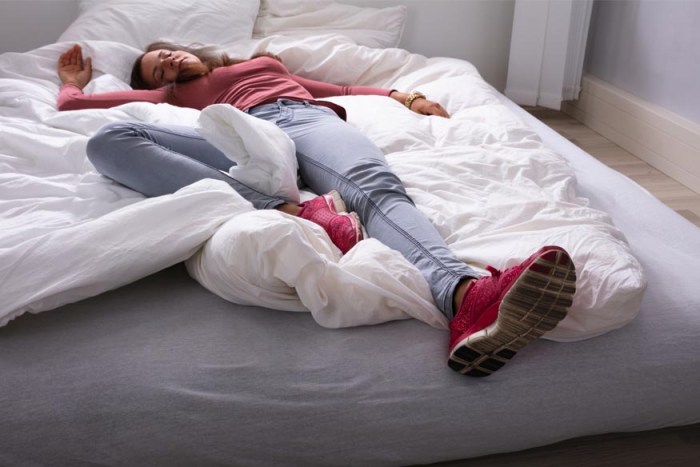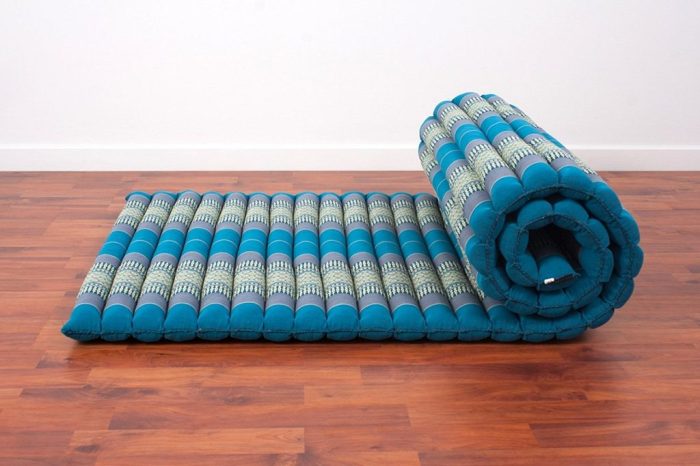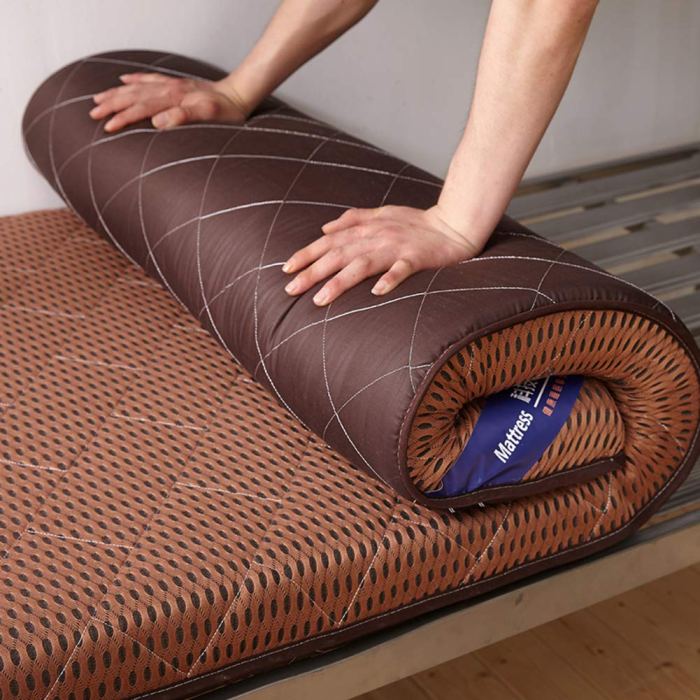Sleeping mattress on floor – Sleeping on the floor with a mattress may seem unconventional, but it offers numerous benefits, from improved posture to better circulation. This comprehensive guide explores the advantages, proper techniques, and essential considerations for sleeping on the floor, empowering you to make an informed decision about this alternative sleep arrangement.
Benefits of Sleeping on the Floor
Sleeping on a mattress on the floor offers several potential advantages that can positively impact your physical and mental well-being.
Sleeping on a mattress on the floor is a great way to save space and improve your posture. Japanese floor mattresses are a popular choice for people who want to sleep on the floor because they are comfortable, supportive, and durable.
They are also relatively inexpensive, making them a great option for people on a budget.
Improved Posture
A firm surface like the floor can help maintain the natural curvature of your spine, reducing strain on your back and neck. This can alleviate pain and stiffness in these areas and improve overall posture.
Reduced Back Pain
Sleeping on the floor can distribute your weight evenly, reducing pressure on specific points in your back. This can alleviate lower back pain, sciatica, and other conditions caused by uneven weight distribution.
Better Circulation
The firm surface of the floor promotes better blood circulation throughout your body. This can reduce swelling in your legs and feet, improve oxygen delivery to your tissues, and enhance your overall energy levels.
Improved Sleep Quality and Duration
Sleeping on the floor may also improve your sleep quality and duration. The firm surface can reduce tossing and turning, while the lack of external support can promote a deeper, more restful sleep.
Choosing the Right Mattress for Floor Sleeping: Sleeping Mattress On Floor
Selecting the right mattress for floor sleeping is crucial for a comfortable and restful night’s sleep. Consider the following factors when making your choice:
Firmness, Sleeping mattress on floor
- Firmness is a matter of personal preference. Firmer mattresses provide better support for the spine, while softer mattresses offer more cushioning and pressure relief.
- For floor sleeping, a medium-firm mattress is generally recommended as it provides a balance of support and comfort.
Thickness
- Thickness affects the level of support and insulation provided by the mattress.
- For floor sleeping, a mattress thickness of 4-6 inches is ideal, providing sufficient support without being too bulky.
Materials
- Different mattress materials offer varying levels of comfort, support, and durability.
- Memory foam mattresses conform to the body, providing excellent pressure relief, while latex mattresses are breathable and offer natural antimicrobial properties.
- Traditional innerspring mattresses offer a balance of support and affordability, but may not be as durable as foam or latex mattresses.
Size and Shape
- The size and shape of the mattress should fit the space available on the floor.
- Consider the height of the mattress to ensure it is not too high or too low for comfortable entry and exit.
Proper Floor Sleeping Techniques

Adopting proper body positioning and alignment is crucial for a comfortable and supportive night’s sleep on the floor. Lie down on your back with your legs extended and your spine straight. Avoid arching your back or curling up in a fetal position, as this can lead to discomfort and pain.
Ensure your head and neck are supported by a pillow or rolled-up blanket to maintain proper alignment.
Use of Pillows and Blankets
Pillows and blankets play a vital role in enhancing comfort and support while sleeping on the floor. Use a firm pillow to support your head and neck, aligning it with your spine. Place additional pillows under your knees or between your legs for added support and to reduce pressure points.
Blankets provide warmth and insulation, so use them as needed to create a comfortable sleeping environment.
Adjusting to Floor Sleeping
Adjusting to sleeping on the floor may take some time and effort. Initially, you may experience discomfort or soreness, especially if your body is not accustomed to sleeping on a firm surface. Start by sleeping on the floor for short periods and gradually increase the duration as you become more comfortable.
Use pillows and blankets to provide support and alleviate any discomfort. Over time, your body will adapt to the new sleeping surface, and you will begin to experience the benefits of floor sleeping.
Creating a Comfortable Floor Sleeping Environment
To enhance your floor sleeping experience, it is crucial to create a cozy and conducive sleeping space. This involves managing temperature, lighting, and noise levels, as well as incorporating decorative elements to create a relaxing ambiance.
When sleeping on a mattress on the floor, one might experience discomfort due to the hardness of the surface. To alleviate this, consider adding a mattress topper . This additional layer of cushioning can provide support and comfort, improving the overall sleep experience.
However, even with a mattress topper, it’s important to ensure proper ventilation and avoid moisture buildup to maintain a hygienic and comfortable sleeping environment.
Firstly, temperature regulation is key. In warmer climates, opt for breathable materials such as cotton or bamboo for your bedding. Consider using a cooling mattress pad or fan to maintain a comfortable sleep temperature. In colder environments, layer up with blankets or a warm comforter, and use a heated mattress pad or space heater to ensure warmth.
Lighting and Noise Control
Lighting plays a significant role in sleep quality. Create a dark and calming atmosphere by using blackout curtains or an eye mask. Avoid using bright or stimulating lights before bedtime, as they can interfere with melatonin production and make it harder to fall asleep.
Similarly, minimize noise disturbances by using earplugs or a white noise machine to block out distracting sounds.
Incorporating Decorative Elements
To enhance the ambiance of your floor sleeping space, consider incorporating decorative elements such as rugs, throws, and pillows. A soft and cozy rug can provide warmth and comfort underfoot, while throws and pillows can add color and texture to the space.
Choose textiles in calming colors and patterns to create a relaxing atmosphere.
Health Considerations

Sleeping on the floor may have potential health implications that should be considered, especially for individuals with pre-existing medical conditions or physical limitations. It is essential to assess your individual circumstances and consult with a healthcare professional before making any significant changes to your sleeping arrangements.
Sleeping on a mattress on the floor can be a great way to save space and improve your sleep. Japanese floor mattresses, also known as tatami, are a traditional type of mattress that is made from natural materials and designed to provide support and comfort.
If you’re looking for a way to improve your sleep and create a more relaxing and comfortable sleeping environment, a japanese floor mattress may be the perfect solution for you. It can provide a firm yet comfortable surface to sleep on, and it can also help to improve your posture and alignment.
For most people, sleeping on the floor is generally safe and can provide various benefits. However, certain individuals may experience discomfort or health concerns due to their unique circumstances.
Back Pain and Spine Health
- Sleeping on a firm surface like the floor can help improve posture and alleviate back pain for some individuals.
- However, those with existing back problems or spinal conditions may find that the lack of cushioning can exacerbate their discomfort.
- Consulting a healthcare professional or physical therapist is recommended to determine the suitability of floor sleeping for your specific back condition.
Joint Pain and Circulation
- Sleeping on the floor can put pressure on joints, particularly the hips, knees, and ankles.
- Individuals with arthritis or other joint pain may experience increased discomfort when sleeping on a hard surface.
- Additionally, sleeping on the floor can restrict blood flow to the extremities, leading to numbness or tingling in the hands and feet.
Allergies and Respiratory Issues
- The floor is often home to dust mites, pet dander, and other allergens.
- Individuals with allergies or respiratory conditions may experience increased symptoms when sleeping on the floor.
- Regular cleaning and the use of hypoallergenic bedding can help mitigate these concerns.
Summary

Whether you seek to alleviate physical ailments, enhance sleep quality, or simply explore a unique sleep experience, sleeping on the floor with a mattress can be a viable option. By following the guidelines Artikeld in this guide, you can create a comfortable and supportive sleep environment on the floor, promoting both physical well-being and restful nights.
FAQ
Is sleeping on the floor bad for your back?
Contrary to popular belief, sleeping on a firm surface like the floor can improve posture and reduce back pain by providing proper support to the spine.
Can I sleep on the floor every night?
Yes, you can sleep on the floor every night as long as you choose a suitable mattress and adjust to the new sleeping arrangement gradually to avoid discomfort.
What is the best mattress for sleeping on the floor?
The best mattress for floor sleeping is firm, supportive, and breathable. Consider memory foam, latex, or traditional innerspring mattresses with a firmness level that suits your body weight and sleep preferences.